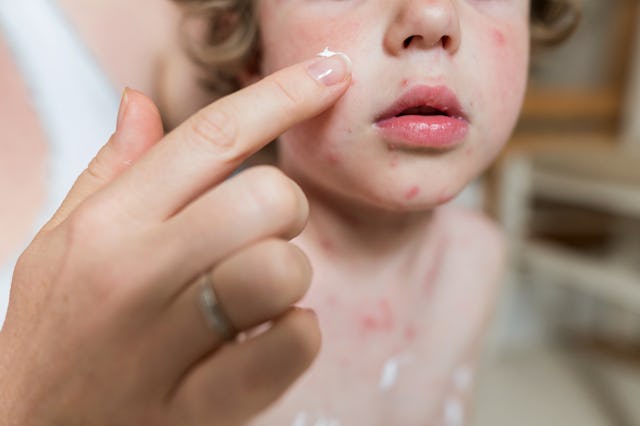My Kid Has Impetigo. WTF Is It, & How Do I Keep Their Hands Off It?
It’s so... crusty.

Every year, parents hear a ton of talk about hand, foot, and mouth disease going around or big lice outbreaks. What you don't seem to hear as much about is impetigo — despite the fact it's the most common skin infection in kids between the ages of 2 and 5. But, other than crusty and gross, what is it? And why should it definitely be on your radar heading into the thick of summer?
In full disclosure, it's pretty awful. If your kid has ever dealt with another skin infection, like ringworms or chickenpox, you know how frustrating it is to watch them struggle with it while you try to keep them from touching and scratching it nonstop. Impetigo is like that... but, honestly, worse.
Still, take heart. Although it looks (and undoubtedly feels) awful, impetigo is treatable and typically doesn't result in complications after recovery.
What is impetigo?
According to the Mayo Clinic, impetigo (pronounced "im-puh-TIE-go") is a highly contagious skin infection that typically affects infants and young children.
Usually caused by bacterial staphylococci organisms, it can be picked up when your child comes in contact with the bacteria from someone infected. This may mean touching their friend's open impetigo sores, playing with the same toys and equipment, or using the same linens or clothes (including dress-ups).
It often strikes in warmer months when kids are outdoors more.
What are the symptoms of impetigo?
Impetigo usually surfaces as sores around a child's mouth or nose. The sores start out red or pink, then open and ooze before forming a honey-colored crust on top. It's... ugly.
Fortunately, it typically only affects the superficial layers of the epidermis. The most common type of superficial impetigo is non-bullous, characterized by itchy sores that burst quickly, red skin where sores have broken, swollen glands, and honey-colored crusted erosion. The second, much rarer, type is bullous impetigo, characterized by fluid-filled blisters without redness that break open and form crusty sores.
A third form of impetigo, ecthyma, causes deeper erosions. Unlike the sores with non-bullous or bullous impetigo, the blisters that form with ecthyma are painful. This type of infection leads to thick crusts and redness on the skin and the potential for scarring as the skin heals.
When do symptoms start, and how long does impetigo last?
Symptoms usually develop within three days of the bacteria infecting your child's skin.
How long it lasts varies from child to child. Studies show that the infection goes away faster when you use antibiotic cream, but even then, it's unlikely the condition will clear up within 24 hours. Expect to be dealing with the rash for days up to a few weeks.
Should you see a doctor for impetigo?
Let's get this out of the way: When it comes to rashes, your friends in that mom group can be wildly helpful — but they should not be your sole source for diagnosis. Any time your kid has a rash, it's in everyone's best interest to get a doctor's opinion.
The easiest way to do this? Snap a few pictures to send through MyChart and then call the office, talk to a nurse, and ask them to take a look. If it's after hours or on the weekend, don't be afraid to use that on-call doctor. That's what they get paid for, and if you can tell them they already have pics available on MyChart, it will make the diagnosis process easier. You can also try going to an urgent care center or "Little Clinic," like you'll find in many grocery stores and pharmacies.
While some rashes and skin conditions only require Benadryl or an OTC cream, others require a more heavy-duty treatment. The latter includes impetigo.
How is impetigo treated?
Depending on the severity and spread, impetigo is treated with doctor-prescribed topical antibiotic ointments or oral antibiotics.
In addition to any antibiotics prescribed, caring for your kiddo's skin can help heal the infection faster. You can do this by gently removing crusts with warm, soapy water and placing a bandage over infected skin areas (if accessible).
How TF do you keep your kid from touching their sores?
Talk about it... a lot.
Have you ever tried to tell your kid not to do something? The results are always laughable, right? For kids who might understand, you should definitely start with a conversation about not spreading germs. Then, keep a close eye and continue to give gentle reminders.
Keep 'em covered.
With rashes on the face, keeping their crustiness under wraps can be harder. However, having your child wear bandages and/or clothing that cover the rash goes a long way in helping them avoid spreading impetigo to the rest of their body. If you're really desperate, no one will judge you for busting out the mittens.
Avoid idle hands.
When you're bored, you pick, scratch, or prod more than usual. This is a great time to give your kiddo extra playtime with their crayons, markers, or clay. Obviously, you'll want to give everything a good wipe-down after playtime.
Can impetigo return?
Yep, sure can — especially in younger kids since, as mentioned, they tend to scratch and spread more. The good news? Once your child recovers from a bout with this icky skin condition, they're unlikely to have any complications or long-lasting issues.